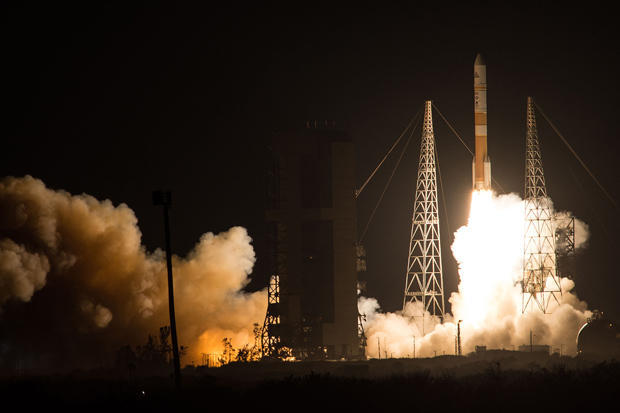Delta 4 boosts powerful military satellite into orbit
A United Launch Alliance Delta 4 rocket boosted a $426 million military communications satellite into orbit Wednesday, the latest -- and most powerful -- in a multi-billion-dollar network that provides high-bandwidth data and video relay for pilots, drone operators, soldiers, sailors and allied military forces around the world.
The Boeing-built satellite, the eighth of 10 Wideband Global SATCOM, or WGS, communications stations, features 90 percent more bandwidth -- up to 11 gigabits per second -- than previous satellites in the series, which already were the most powerful relay stations operated by the military.
“The information age has resulted in an explosion of communications demand capability for everyone globally,” Rico Attanasio, director of Boeing’s military comsat programs, told reporters before launch. “And for our armed forces and DOD users, wideband communications is vitally important to executing missions that defend and protect the people of the United States and our interests.
“More and more, WGS is called upon to deliver reliable, high-data-rate communications anywhere in the world, sometimes in contested environments.”
The WGS 8 mission got underway at 6:53 p.m. EST (GMT-5) when the Delta 4’s hydrogen-fueled RS-68A first-stage engine fired up, followed moments later by ignition of four strap-on solid-fuel boosters.
Generating a combined 1.8 million pounds of thrust, the 217-foot-tall rocket smoothly climbed away from launch complex 37 at the Cape Canaveral Air Force Station, lighting up the evening sky with a brilliant jet of exhaust as it consumed its first-stage load of propellants, shed weight and quickly accelerated.
The strap-on boosters burned out and and were jettisoned about one minute and 42 seconds after liftoff and the Aerojet Rocketdyne first stage engine shut down as planned just under four minutes into flight.
The spent first stage then fell away and the second stage RL10B-2 engine ignited and fired for another 15-and-a-half minutes to put the vehicle and its satellite payload into a preliminary elliptical orbit.
A second three-minute burn fine-tuned the initial orbit and 42 minutes after liftoff, the 13,000-pound Wideband Global Satcom 8 satellite was released into a so-called “super-synchronous” transfer orbit with a low point of around 270 miles and a predicted high point of about 27,600 miles.
Over the next several weeks, small on-board thrusters will be used to raise the low point of the transfer orbit, putting the relay station into an operational altitude 22,300 miles above the equator.
In such “geosynchronous” orbits, satellites take 24 hours to complete one trip around the planet and appear to hang stationary in the sky as Earth rotates, allowing anyone within line of sight to communicate with the spacecraft or receive video or data.
Once in its final orbit, Boeing engineers will spend several weeks checking out and testing the relay station and maneuvering it to a classified position before turning it over to the Pentagon for normal operations.
WGS 8 is the eighth in a planned constellation of 10 communications stations that are replacing older Defense Satellite Communication System spacecraft.
The satellites are used by all branches of the U.S. military, along with the White House and the State Department. Australia, Canada, Denmark, the Netherlands, Luxembourg and New Zealand paid for two of the satellites in the fleet and are able to use the network in return.
Each WGS spacecraft has 10 times the capability of the older satellites and, starting with WGS-7, an additional 17 percent improvement in bandwidth thanks to operational changes. But WGS 8 ups the ante with 90 percent more bandwidth than earlier models, thanks to a high-tech router-like device known as a Wideband Digital Channelizer provided by IBM.
“The channelizer on WGS 8 essentially performs the same function as WGS-1 through 7,” Attanasio said. “It is a router in orbit. It basically takes radio frequency input from the ground, converts that to digital and then is able to route and move things around.”
Using a “computer on a chip” known as an application-specific integrated circuit, the new channelizer “improved our processing capability on board the spacecraft,” Attanasio said.
“We were able to open up more availability and routes of information through that router,” he said. “By opening up those additional routes, we provided additional flexibility and more available bandwidth to the user.”
The solar-powered satellite features eight steerable X-band beams and 10 Ka-band beams covering 19 independent coverage areas, along with full-Earth coverage in X-band.
The satellites handle a wide variety of communications chores ranging from relaying maps and data to soldiers in the field, to video from remotely piloted drones, voice calls and data messaging. They also relay email and television broadcasts to troops in the field.
“We’re simply making more bandwidth available and it will go to the users who are in that area,” said Charlotte Gerhart, WGS program manager for the Air Force. “There’s no specific user who is targeted, and there’s no specific area. Wherever WGS 8 is and whatever capacity is requested, the system will provide it.”
This was the 34th launch of a Delta 4 rocket since the current version of the booster began flying in 2002, all of them successful. Including the Atlas 5, ULA rockets have now flown 114 successful missions in a row. ULA, a partnership between Boeing and Lockheed Martin, was formed in December 2006.





